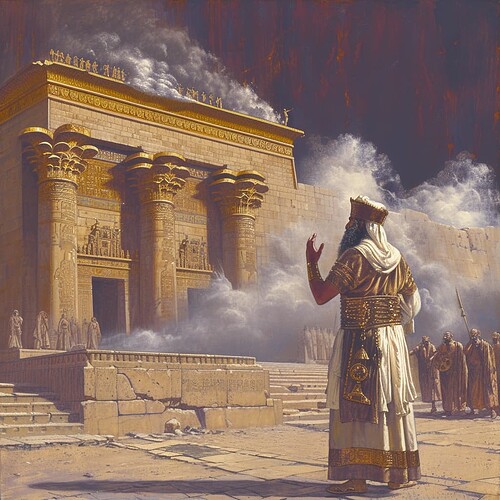 February 26: Exodus 39, 40: Faith and Obedience Establishes The Tabernacle
February 26: Exodus 39, 40: Faith and Obedience Establishes The Tabernacle
 Introduction
Introduction
In Exodus 39 and 40, we witness the Israelites’ faith and obedience in action as they follow God’s specific directions in crafting and setting up the Tabernacle. This is a beautiful display of God’s sovereignty and man’s devoted obedience: a blueprint of communion between the Creator and His people.
 Exodus 39: The Priestly Garments
Exodus 39: The Priestly Garments
The Israelites, with Bezalel and Oholiab at the helm, craft the priestly garments with precision and care, following God’s instructions to the letter.
![]() Key Verse: Exodus 39:43 – “And Moses did look upon all the work, and, behold, they had done it as the Lord had commanded, even so, had they done it: and Moses blessed them.”
Key Verse: Exodus 39:43 – “And Moses did look upon all the work, and, behold, they had done it as the Lord had commanded, even so, had they done it: and Moses blessed them.”
 Exodus 40: Setting up The Tabernacle
Exodus 40: Setting up The Tabernacle
The tabernacle is erected, and the ark of the covenant is established in its Most Holy Place. Moses consecrates Aaron and his sons to serve as priests in this dwelling place of God.
![]() Key Verse: Exodus 40:34 – “Then a cloud covered the tent of the congregation, and the glory of the Lord filled the tabernacle.”
Key Verse: Exodus 40:34 – “Then a cloud covered the tent of the congregation, and the glory of the Lord filled the tabernacle.”
 Key Themes and Reflections
Key Themes and Reflections
- Faith and Obedience: The Israelites meticulously follow God’s instructions, demonstrating profound faith and obedience which are the cornerstones of spirituality.
- God’s Presence: When the work is completed, God’s glory fills the tabernacle, signifying His constant presence among His people.
 Today’s Application
Today’s Application
We are God’s living tabernacles today. By adhering to His teachings in every aspect of our lives, we invite His glory and presence into our hearts, shaping us into vessels of His love and grace.
 Hidden Gem
Hidden Gem
An interesting nugget: the completion of the tabernacle occurred exactly one year after the Israelites’ exodus from Egypt. The journey from slavery to crafting God’s chosen dwelling place is indeed remarkable!
 Reflective Q&A
Reflective Q&A
![]() What do the priestly garments represent?
What do the priestly garments represent?
A: They symbolised divine righteousness, holiness, and commitment to servant leadership.
![]() How does the presence of God in the Tabernacle apply to us today?
How does the presence of God in the Tabernacle apply to us today?
A: Like the Tabernacle, we are to be the dwelling place of God’s Spirit, bringing His glory to the world.
 Join the Discussion
Join the Discussion
What actions display your faith and obedience to God?
 See You Tomorrow in Leviticus 1, 2
See You Tomorrow in Leviticus 1, 2
Coming up next, we delve into the Book of Leviticus where instructions are given regarding offerings to the Lord. See you soon in our shared journey!
